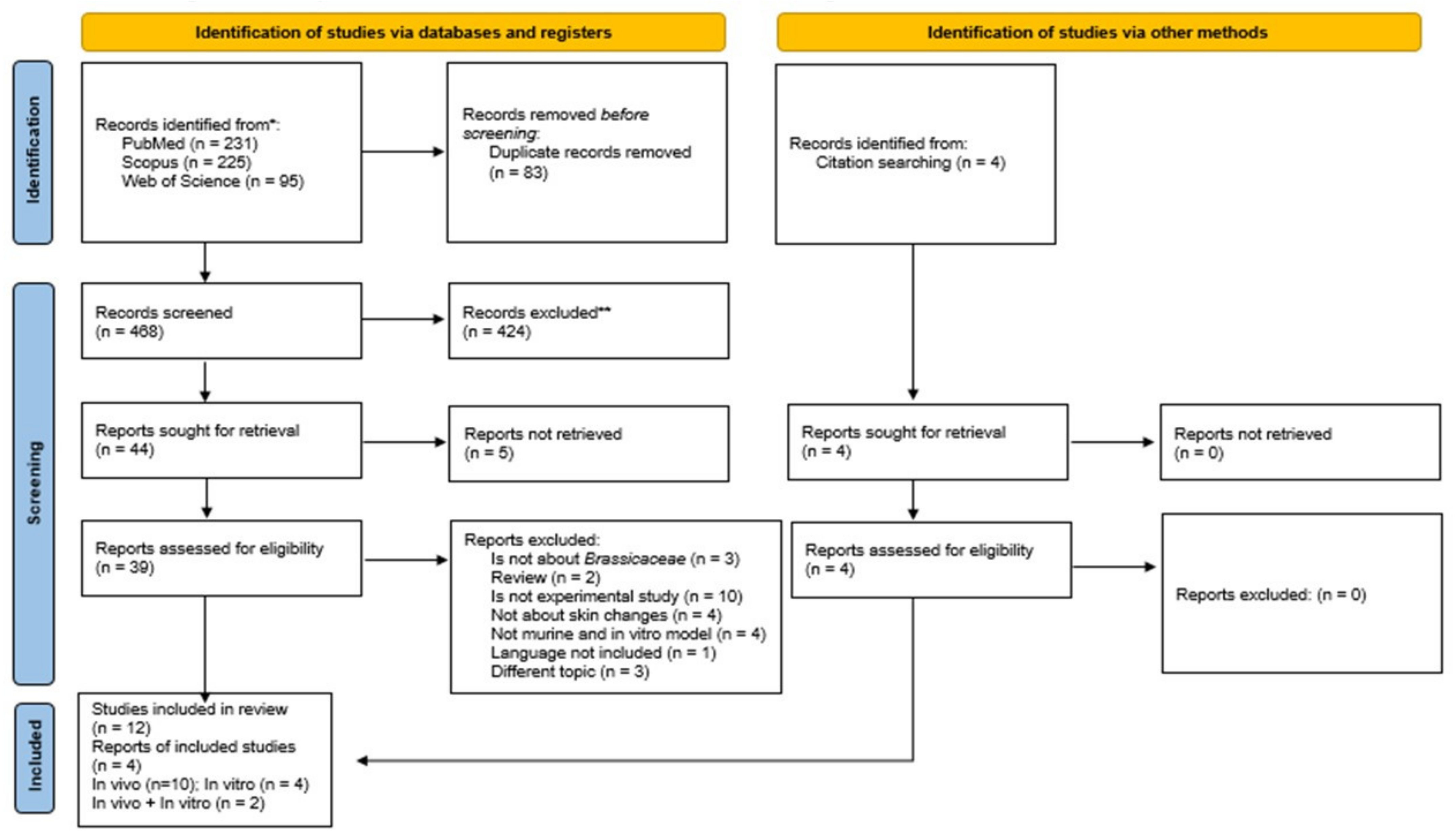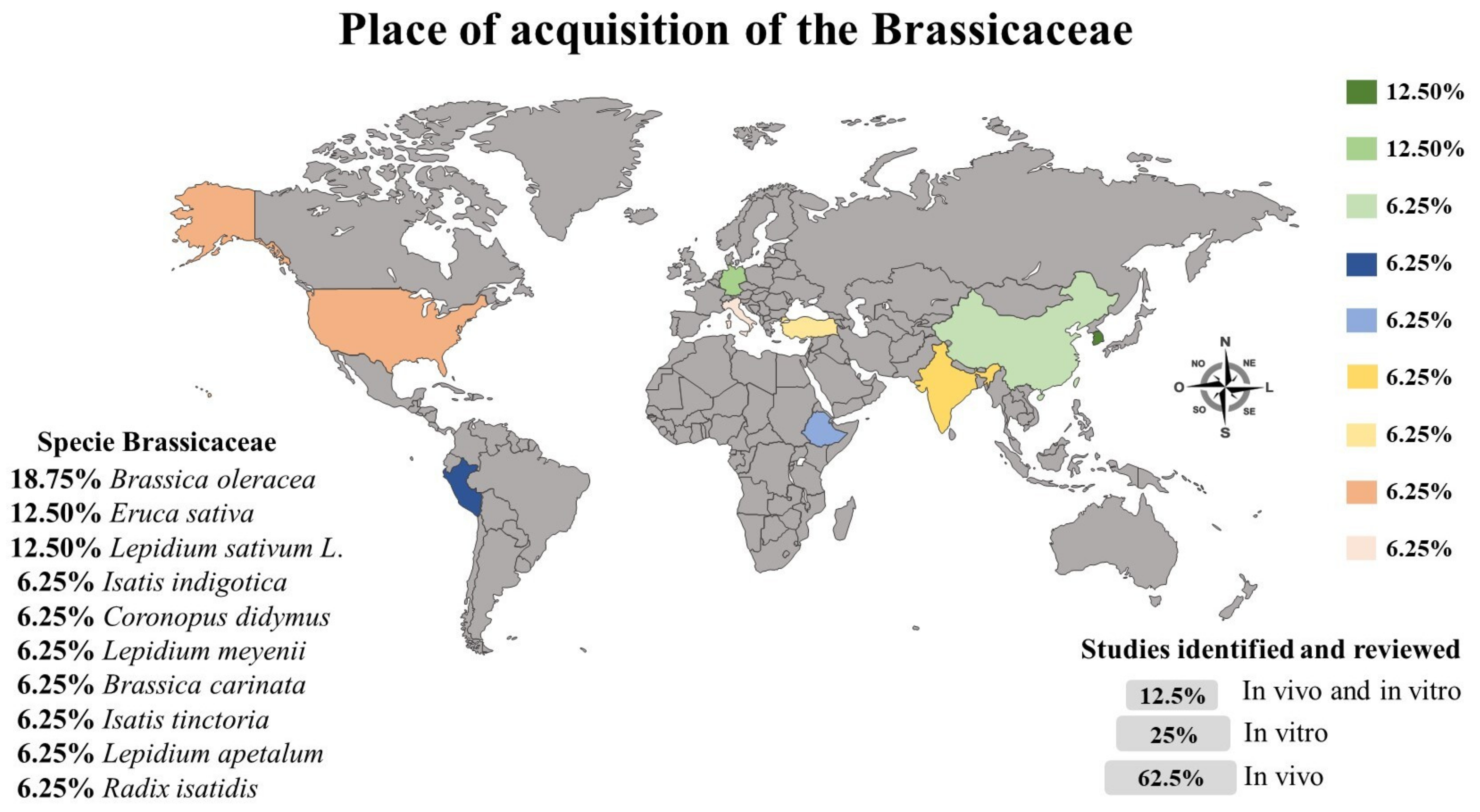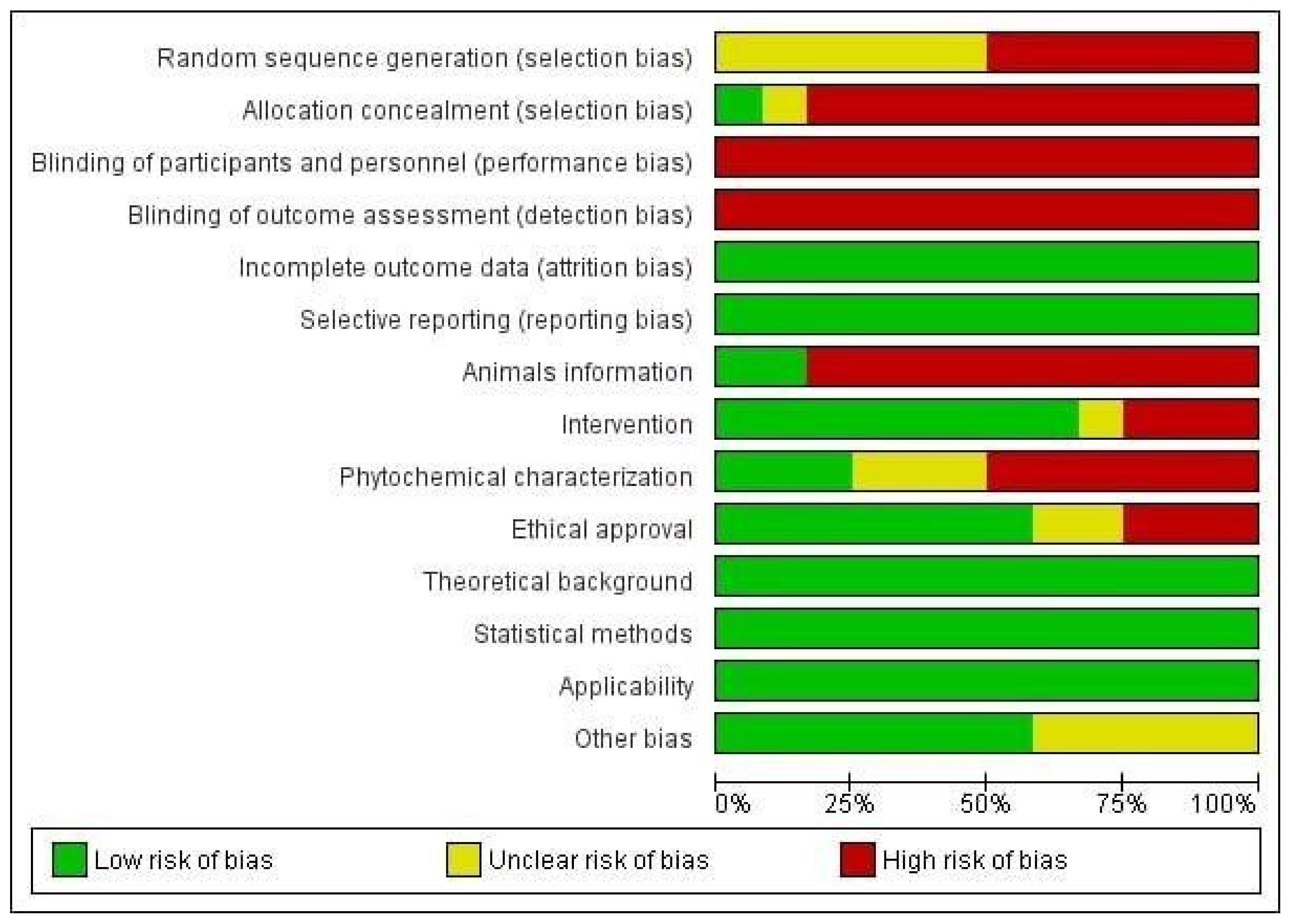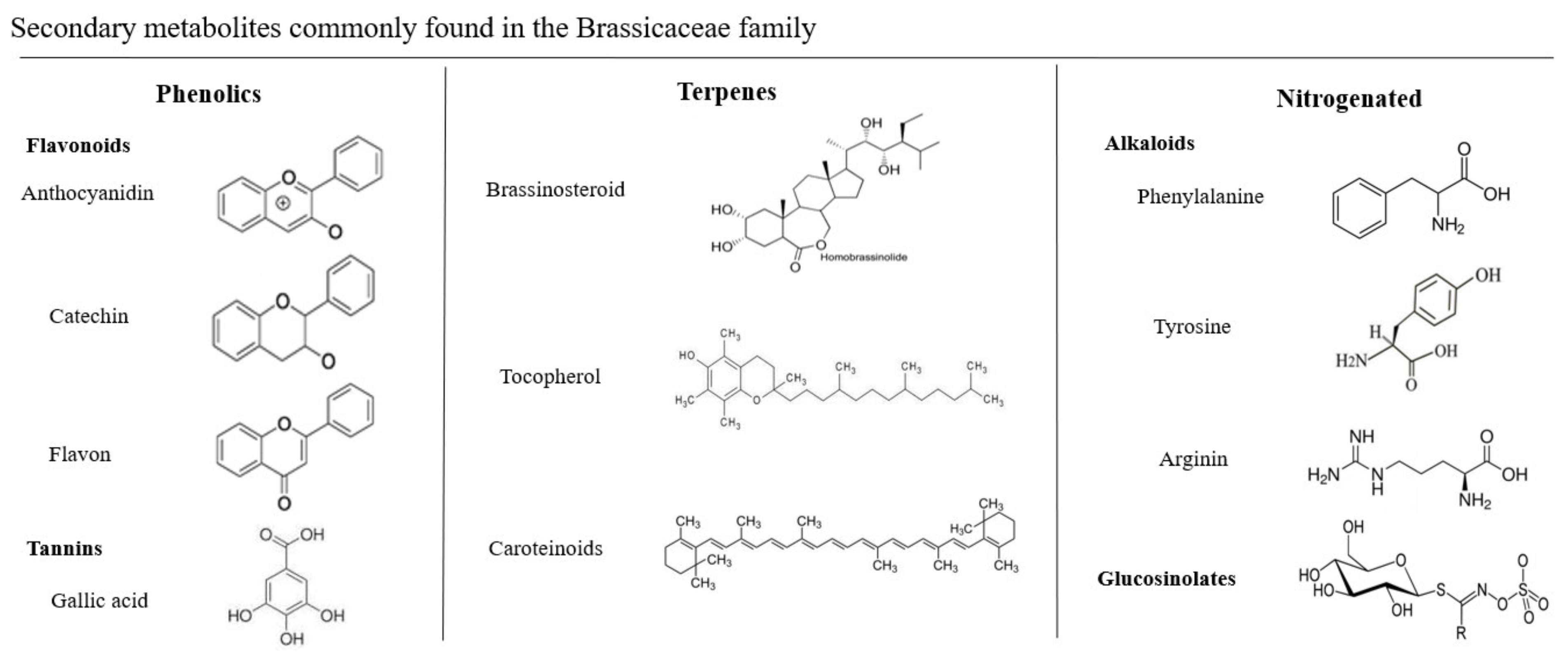Anti-Inflammatory, Antioxidant, and Skin Regenerative Potential of Secondary Metabolites from Plants of the Brassicaceae Family: A Systematic Review of In Vitro and In Vivo Preclinical Evidence (Biological Activities Brassicaceae Skin Diseases)
Abstract
1. Introduction
2. Methods and Materials
2.1. Focus Question
2.2. Search Strategy
2.3. Eligibility Criteria
- (1)
- Studies that evaluate Brassicas exposure in the skin changes.
- (2)
- In vivo and in vitro studies of changes in the skin with murine models.
- (3)
- Studies evaluating the effect of Brassicaceae on the inflammatory process associated with edema and wound healing.
2.4. Data Extraction and Synthesis from In Vivo and In Vitro Studies
2.5. Risk of Bias Assessment from In Vivo Studies
3. Results
3.1. PRISMA Guideline
3.2. Characteristics of Publication
3.3. In Vivo Model
3.3.1. Characteristics of the Animal Model
3.3.2. Characteristics of Treatments
3.3.3. Main Outcomes
3.3.4. Reporting Bias In Vivo Studies
3.4. In vitro Models
3.4.1. Characteristics of the Culture Cells
3.4.2. Characteristics of Treatments
3.4.3. Main Outcomes
3.5. Secondary Metabolites Found in Brassicas
4. Discussion
4.1. General Characteristics
4.2. Characteristics of In Vivo Studies
4.3. Characteristics of In Vitro Studies
4.4. Phytochemical Composition of Brassicaceae and Their Anti-Inflammatory, Antioxidant, and Healing Actions
5. Conclusions
Supplementary Materials
Author Contributions
Funding
Institutional Review Board Statement
Informed Consent Statement
Data Availability Statement
Conflicts of Interest
References
- García, E.R.; Barros, E.; Stransky, S.; Chávez-Olórtegui, C.; Freitas, M.B.; Novaes, R.D.; Gonçalves, R.V. Acidic Phospholipase A2-Peptide Derivative Modulates Oxidative Status and Microstructural Reorganization of Scar Tissue after Cutaneous Injury. Evid. Based Complementary Altern. Med. 2020, 2020, 1–13. [Google Scholar] [CrossRef] [PubMed]
- Mittag, B.F.; Krause, T.C.C.; Roehrs, H.; Meier, M.J.; Danski, M.T.R. Cuidados com Lesão de Pele: Ações da Enfermagem. Rev. Estima 2017, 15, 19–25. [Google Scholar] [CrossRef]
- Altoé, S.L.; Alves, S.R.; Miranda, L.L.; Sarandy, M.M.; Bastos, S.S.D.; Gonçalves-Santos, E.; Novaes, D.R.; Gonçalves, V.R. Doxycycline Hyclate Modulates Antioxidant Defenses, Matrix Metalloproteinases, and COX-2 Activity Accelerating Skin Wound Healing by Secondary Intention in Rats. Oxidative Med. Cell. Longev. 2021, 2021, 1–16. [Google Scholar] [CrossRef] [PubMed]
- Larouche, J.; Sheoran, S.; Maruyama, K.; Martino, M.M. Immune Regulation of Skin Wound Healing: Mechanisms and Novel Therapeutic Targets. Adv. Wound Care 2018, 7, 209–231. [Google Scholar] [CrossRef]
- Del Rosario Loyo Casao, T.; Pinheiro, C.G.; Sarandy, M.M.; Zanatta, A.C.; Vilegas, W.; Novaes, R.D.; Viana Leite, J.P. Croton urucurana Baillon stem bark ointment accelerates the closure of cutaneous wounds in knockout IL-10 mice. J. Ethnopharmacol. 2020, 261, 113042. [Google Scholar] [CrossRef]
- Mittal, M.; Siddiqui, M.R.; Tran, K.; Reddy, S.P.; Malik, A.B. Reactive Oxygen Species in Inflammation and Tissue Injury. Antioxid. Redox Signal. 2014, 20, 1126–1167. [Google Scholar] [CrossRef]
- Koch, M.A.; German, D.A.; Kiefer, M.; Franzke, A. Database Taxonomics as Key to Modern Plant Biology. Trends Plant Sci. 2018, 23, 4–6. [Google Scholar] [CrossRef]
- Warwick, S.I.; Francis, A.; Al-Shehbaz, I.A. Brassicaceae: Species checklist and database on CD-Rom. Plant Syst. Evol. 2006, 259, 249–258. [Google Scholar] [CrossRef]
- Gerszberg, A.; Hnatuszko-Konka, K.; Kowalczyk, T. In vitro regeneration of eight cultivars of Brassica oleracea var. capitata. Vitr. Cell. Dev. Biol. Plant 2015, 25, 80–87. [Google Scholar] [CrossRef]
- Esposito, D.; Rathinasabapathy, T.; Schmidt, B.; Shakarjian, M.P.; Komarnytsky, S.; Raskin, I. Acceleration of cutaneous wound healing by brassinosteroids. Wound Repair Regen. 2013, 21, 688–696. [Google Scholar] [CrossRef]
- Kohli, S.K.; Bhardwaj, A.; Bhardwaj, V.; Sharma, A.; Kalia, N.; Landi, M.; Bhardwaj, R. Therapeutic Potential of Brassinosteroids in Biomedical and Clinical Research. Biomolecules 2020, 10, 572. [Google Scholar] [CrossRef]
- Page, M.J.; Moher, D.; Bossuyt, P.M.; Boutron, I.; Hoffmann, T.C.; Mulrow, C.D.; Shamseer, L.; Tetzlaff, J.M.; Akl, E.A.; Brennan, S.E.; et al. PRISMA 2020 explanation and elaboration: Updated guidance and exemplars for reporting systematic reviews. BMJ 2021, 29, 372. [Google Scholar] [CrossRef]
- Hooijmans, C.R.; Tillema, A.; Leenaars, M.; Ritskes-Hoitinga, M. Enhancing search efficiency by means of a search filter for finding all studies on animal experimentation in PubMed. Lab. Anim. 2010, 44, 170–175. [Google Scholar] [CrossRef]
- Alemu, B.K.; Getahun, K.B.; Kahaliw, W. In vitro Antioxidant and in vivo Wound Healing Activities of the 80% Methanol Extract and Solvent Fractions of Seeds of Brassica carinata A. Braun (Brassicaceae) in Mice. J. Exp. Pharmacol. 2020, 12, 463–474. [Google Scholar] [CrossRef]
- Al-Yahya, M.A.; Mossa, J.S.; Ageel, A.M.; Rafatullah, S. Pharmacological and safety evaluation studies on Lepidium sativum L., Seeds. Phytomedicine 1994, 1, 155–159. [Google Scholar] [CrossRef]
- Dey, M. In Vitro and in Vivo Anti-Inflammatory Activity of a Seed Preparation Containing Phenethylisothiocyanate. J. Pharmacol. Exp. Ther. 2005, 317, 326–333. [Google Scholar] [CrossRef]
- Gonçalves, R.V.; Sarandy, M.M.; da Matta, S.L.P.; Novaes, R.D.; Pinto, M.V.M. Comparative study of the effects of laser photobiomodulation and extract of Brassica oleracea on skin wounds in wistar rats: A histomorphometric study. Pathol. Res. Pract. 2013, 209, 648–653. [Google Scholar] [CrossRef]
- Ho, Y.L.; Chang, Y.S. Studies on the antinociceptive, anti-inflammatory and antipyretic effects of Isatis indigotica root. Phytomedicine 2002, 9, 419–424. [Google Scholar] [CrossRef]
- De Oliveira Leite, G.; Leite, L.H.I.; de Souza Sampaio, R.; Araruna, M.K.A.; de Menezes, I.R.A.; da Costa, J.G.M.; Campos, A.R. (−)-α-Bisabolol attenuates visceral nociception and inflammation in mice. Fitoterapia 2011, 82, 208–211. [Google Scholar] [CrossRef]
- Nuñez, D.; Olavegoya, P.; Gonzales, G.F.; Gonzales-Castañeda, C. Red Maca (Lepidium meyenii), a Plant from the Peruvian Highlands, Promotes Skin Wound Healing at Sea Level and at High Altitude in Adult Male Mice. High Alt. Med. Biol. 2017, 18, 372–383. [Google Scholar] [CrossRef]
- Prabhakar, K.R.; Srinivasan, K.K.; Rao, P.G.M. Chemical Investigation, Anti-inflammatory and Wound Healing Properties of Coronopus didymus. Pharm. Biol. 2002, 40, 490–493. [Google Scholar] [CrossRef]
- Rebolla, A.; Arisawa, E.A.L.S.; Barja, P.R.; Posso, M.B.S.; da Carvalho, S.C. Effect of Brassica oleracea in rats skin wound healing. Acta Cir. Bras. 2013, 28, 664–669. [Google Scholar] [CrossRef] [PubMed]
- Recio, M.C.; Cerdá-Nicolás, M.; Potterat, O.; Hamburger, M.; Ríos, J.L. Anti-Inflammatory and Antiallergic Activityin vivoof LipophilicIsatis tinctoria Extracts and Tryptanthrin. Planta Med. 2006, 72, 539–546. [Google Scholar] [CrossRef] [PubMed]
- Sarandy, M.M.; Novaes, R.D.; da Matta, S.L.P.; Mezencio, J.M.D.S.; da Silva, M.B.; Zanuncio, J.C.; Gonçalves, R.V. Ointment of Brassica oleracea var. capitata Matures the Extracellular Matrix in Skin Wounds of Wistar Rats. Evid. Based Complementary Altern. Med. 2015, 2015, 1–9. [Google Scholar] [CrossRef]
- Shin, E.K.; Kim, D.H.; Lim, H.; Shin, H.K.; Kim, J.K. The Anti-Inflammatory Effects of a Methanolic Extract from Radix isatidis in Murine Macrophages and Mice. Inflammation 2009, 33, 110–118. [Google Scholar] [CrossRef]
- Kim, B.; Choi, Y.E.; Kim, H.S. Eruca sativa and its Flavonoid Components, Quercetin and Isorhamnetin, Improve Skin Barrier Function by Activation of Peroxisome Proliferator-Activated Receptor (PPAR)-α and Suppression of Inflammatory Cytokines. Phytother. Res. 2014, 28, 1359–1366. [Google Scholar] [CrossRef]
- Mazumder, A.; Dwivedi, A.; du Preez, J.L.; du Plessis, J. In vitro wound healing and cytotoxic effects of sinigrin–phytosome complex. Int. J. Pharm. 2016, 498, 283–293. [Google Scholar] [CrossRef] [PubMed]
- Türkoğlu, M.; Kılıç, S.; Pekmezci, E.; Kartal, M. Evaluating Antiinflammatory and Antiandrogenic Effects of Garden Cress (Lepidium sativum L.) in HaCaT cells. Rec. Nat. Prod. 2018, 12, 595–601. [Google Scholar] [CrossRef]
- Yehuda, H.; Khatib, S.; Sussan, I.; Musa, R.; Vaya, J.; Tamir, S. Potential skin antiinflammatory effects of 4-methylthiobutylisothiocyanate (MTBI) isolated from rocket (Eruca sativa) seeds. BioFactors 2009, 35, 295–305. [Google Scholar] [CrossRef]
- Valli, M.; dos Santos, R.N.; Figueira, L.D.; Nakajima, C.H.; Castro-Gamboa, I.; Andricopulo, A.D.; Bolzani, V.S. Development of a Natural Products Database from the Biodiversity of Brazil. J. Nat. Prod. 2013, 76, 439–444. [Google Scholar] [CrossRef] [PubMed]
- Dutra, R.C.; Campos, M.M.; Santos, A.R.S.; Calixto, J.B. Medicinal plants in Brazil: Pharmacological studies, drug discovery, challenges and perspectives. Pharmacol. Res. 2016, 112, 4–29. [Google Scholar] [CrossRef]
- Kusznierewicz, B.; Bartoszek, A.; Wolska, L.; Drzewiecki, J.; Gorinstein, S.; Namieśnik, J. Partial characterization of white cabbages (Brassica oleracea var. capitata f. alba) from different regions by glucosinolates, bioactive compounds, total antioxidant activities and proteins. LWT Food Sci. Technol. 2008, 41, 1–9. [Google Scholar] [CrossRef]
- Sasaki, K.; Takahashi, T. A flavonoid from Brassica rapa flower as the UV-absorbing nectar guide. Phytochemistry 2002, 61, 339–343. [Google Scholar] [CrossRef]
- Nogueira, B.C.F.; Campos, A.K.; Alves, R.S.; Sarandy, M.M.; Novaes, R.D.; Esposito, D.; Gonçalves, R.V. What Is the Impact of Depletion of Immunoregulatory Genes on Wound Healing? A Systematic Review of Preclinical Evidence. Oxidative Med. Cell. Longev. 2020, 2020, 1–19. [Google Scholar] [CrossRef]
- Ferreira, L.M.; Hochman, B.; Barbosa, V.J. Experimental models in research. Acta Cirúrgica Bras. 2005, 18, 4–14. [Google Scholar] [CrossRef][Green Version]
- Trøstrup, H.; Thomsen, K.; Calum, H.; Hoiby, N.; Moser, C. Animal models of chronic wound care: The application of biofilms in clinical research. Chronic Wound Care Manag. Res. 2016, 3, 123–132. [Google Scholar] [CrossRef]
- Andrade, A.; Pinto, S.C.; Oliveira, R.S. Fatores Que Influenciam no Resultado do Experimento Animal. Animais de Laboratório: Criação e Experimentação; Editora Fiocruz: Rio de Janeiro, Brazil, 2002; 388p, ISBN 85-7541-015-6. [Google Scholar]
- Ozay, Y.; Guzel, S.; Ozkorkmaz, E.G. Effects of methanolic extract of Verbascum inulifolium Hub.-Mor. on incisional and excisional skin wounds in diabetic and non-diabetic rats. Indian J. Exp. Biol. 2019, 57, 157–167, ID: Sea-191437. [Google Scholar]
- Alves, R.S.; Alves, L.B.; Altoé, L.S.; Sarandy, M.M.; Freitas, M.B.; Silveira, N.J.F.; Gonçalves, R.V. Peptides from Animal Origin: A Systematic Review on Biological Sources and Effects on Skin Wounds. Oxidative Med. Cell. Longev. 2020, 2020, 1–12. [Google Scholar] [CrossRef]
- Qing, C. The molecular biology in wound healing & non-healing wound. Chin. J. Traumatol. 2017, 20, 189–193. [Google Scholar] [CrossRef]
- McCarson, K.E.; Fehrenbacher, J.C. Models of Inflammation: Carrageenan- or Complete Freund’s Adjuvant (CFA)–Induced Edema and Hypersensitivity in the Rat. Curr. Protoc. 2021, 1, e202. [Google Scholar] [CrossRef]
- Paschapur, M.S.; Patil, M.B.; Kumar, R.; Patil, S.R. Evaluation of anti-inflammatory activity of ethanolic extract of Borassus flabellifer L. male flowers (inflorescences) in experimental animals. J. Med. Plants Res. 2009, 3, 49–54, ISSN 1996-0875. [Google Scholar]
- Sini, J.M.; Yaro, A.H.; Ayanwuyi, L.O.; Aiyelero, O.M.; Mallum, S.M.; Gamaniel, K.S. Antinociceptive and anti-inflammatory activities of the aqueous extract of the root bark of Combretum sericeum in rodents. Afr. J. Biotechnol. 2010, 9, 8872–8876. [Google Scholar] [CrossRef]
- Khan, I.; Dey, D.K.; Lee, J.H.; Kang, S.C. Bamboo leave extract ameliorated 12-O-tetradecanoylphorbol-13-acetate (TPA) induced ear inflammation by reducing MAP kinase levels and NF-κB activation in mice model. Nat. Prod. Res. 2020, 35, 5299–5303. [Google Scholar] [CrossRef]
- Hiraganahalli, B.D.; & Evan, P.S. Effect of Baricitinib on TPA-induced psoriasis like skin inflammation. Life Sci. 2021, 279, 119655. [Google Scholar] [CrossRef]
- Xian, Y.F.; Zhen, H.; Ip, S.P.; Jian Nan, C.; Zi Ren, S.; Xiao Ping, L.; Lin, Z.X. Comparison of the Anti-inflammatory Effects of Sinapis alba and Brassica juncea in Mouse Models of Inflammation. Phytomedicine 2018, 50, 196–204. [Google Scholar] [CrossRef]
- Rodrigues, K.; Chibli, L.; Santos, B.; Temponi, V.; Pinto, N.; Scio, E.; Sousa, O. Evidence of Bioactive Compounds from Vernonia polyanthes Leaves with Topical Anti-Inflammatory Potential. Int. J. Mol. Sci. 2016, 17, 1929. [Google Scholar] [CrossRef]
- Rotelli, A. Comparative study of flavonoids in experimental models of inflammation. Pharmacol. Res. 2003, 78, 601–606. [Google Scholar] [CrossRef]
- Seo, M.D.; Kang, T.J.; Lee, C.H.; Lee, A.Y.; Noh, M.S. HaCaT Keratinocytes and Primary Epidermal Keratinocytes Have Different Transcriptional Profiles of Cornified Envelope-Associated Genes to T Helper Cell Cytokines. Biomol. Ther. 2012, 20, 171–176. [Google Scholar] [CrossRef] [PubMed]
- Santoro, M.; Gaudino, G. Cellular and molecular facets of keratinocyte reepithelization during wound healing. Exp. Cell Res. 2005, 304, 274–286. [Google Scholar] [CrossRef] [PubMed]
- Garbuzenko, E.; Nagler, A.; Pickholtz, D.; Gillery, P.; Reich, R.; Maquart, F.X.; Levi-Schaffer, F. Human mast cells stimulate fibroblast proliferation, collagen synthesis and lattice contraction: A direct role for mast cells in skin fibrosis. Clin. Exp. Allergy 2002, 32, 237–246. [Google Scholar] [CrossRef]
- Kikuchi, K.; Kadono, T.; Takehara, K. Effects of Various Growth Factors and Histamine on Cultured Keloid Fibroblasts. Dermatology 1995, 190, 4–8. [Google Scholar] [CrossRef]
- Hänel, K.; Cornelissen, C.; Lüscher, B.; Baron, J. Cytokines and the Skin Barrier. Int. J. Mol. Sci. 2013, 14, 6720–6745. [Google Scholar] [CrossRef]
- Chen, L.; Deng, H.; Cui, H.; Fang, J.; Zuo, Z.; Deng, J.; Zhao, L. Inflammatory responses and inflammation-associated diseases in organs. Oncotarget 2018, 9, 7204–7218. [Google Scholar] [CrossRef]
- Liu, T.; Zhang, L.; Joo, D.; Sun, S.C. NF-κB signaling in inflammation. Signal Transduct. Target. Ther. 2017, 2, e17023. [Google Scholar] [CrossRef]
- Oeckinghaus, A.; Ghosh, S. The NF-B Family of Transcription Factors and Its Regulation. Cold Spring Harb. Perspect. Biol. 2009, 1, a000034. [Google Scholar] [CrossRef]
- Yao, C.; Narumiya, S. Prostaglandin-cytokine crosstalk in chronic inflammation. Br. J. Pharmacol. 2019, 174, 337–354. [Google Scholar] [CrossRef]
- Lee, Y.; Kim, S.; Yang, B.; Lim, C.; Kim, J.H.; Kim, H.; Cho, S. Anti-inflammatory Effects of Brassica oleracea var. capitata L. (Cabbage) Methanol Extract in Mice with Contact Dermatitis. Pharmacogn. Mag. 2018, 14, 174–179. [Google Scholar] [CrossRef]
- Akdaş, Z.Z.; Bakkalbaşı, E. Influence of Different Cooking Methods on Colour, Bioactive Compounds and Antioxidant Activity of Kale. Int. J. Food Prop. 2017, 20, 877–887. [Google Scholar] [CrossRef]
- Ludwiczuk, A.; Skalicka-Woźniak, K.; Georgiev, M.I. Terpenoids. Pharmacognosy 2017, 11, 233–266. [Google Scholar] [CrossRef]
- Cazarolli, L.; Zanatta, L.; Alberton, E.; Bonorino, M.S.F.; Folador, P.; Damazio, R.; Barreto, F.R.S. Flavonóides: Candidatos a drogas em perspectiva. Mini Rev. Med. Chem. 2008, 8, 1429–1440. [Google Scholar] [CrossRef]
- Kim, H.P.; Son, K.H.; Chang, H.W.; Kang, S.S. Anti-inflammatory Plant Flavonoids and Cellular Action Mechanisms. J. Pharmacol. Sci. 2004, 96, 229–245. [Google Scholar] [CrossRef]
- Biondo-Simões, M.L.P.; Pessini, V.C.A.; Ichi, C.A.; Robes, R.R.; Ioshii, S. Acetylsalicylic acid (Aspirin®) and liver regeneration: Experimental study in rats. Rev. Colégio Bras. Cir. 2021, 22, e20213164. [Google Scholar] [CrossRef]
- Bucker-Neto, L.; Paiva, A.L.S.; Machado, R.D.; Arenhart, R.A.; Margis-Pinheiro, M. Interactions between plant hormones and heavy metals responses. Genet. Mol. Biol. 2017, 40, 373–386. [Google Scholar] [CrossRef]
- Zhao, Y.; Yue, Z.; Zhong, X.; Lei, J.; Tao, P.; Li, B. Distribution of primary and secondary metabolites among the leaf layers of headed cabbage (Brassica oleracea var. capitata). Food Chem. 2019, 312, 126028. [Google Scholar] [CrossRef]
- Dey, P.; Kundu, A.; Kumar, A.; Gupta, M.; Lee, B.M.; Bhakta, T.; Kim, H.S. Analysis of alkaloids (indole alkaloids, isoquinoline alkaloids, tropane alkaloids). Recent Adv. Nat. Prod. Anal. 2020, 15, 505–567. [Google Scholar]
- Blažević, I.; Montaut, S.; Burčul, F.; Olsen, C.E.; Burow, M.; Rollin, P.; Agerbirk, N. Glucosinolate structural diversity, identification, chemical synthesis and metabolism in plants. Phytochemistry 2020, 169, 112100. [Google Scholar] [CrossRef]
- Herbert, R.B. The Biosynthesis of Secondary Metabolites; Department of Organic Chemistry, University of Leeds, Chapman and Hall Ltd.: London, UK, 1981; p. 222. [Google Scholar]
- Borges, L.P.; Amorim, V.A. Secondary plant metabolites. Rev. Agrotecnologia 2020, 11, 54–67. [Google Scholar]
- Pereira, R.J.; Cardoso, M.D.G. Vegetable secondary metabolites and antioxidants benefits. J. Biotechnol. Biodivers. 2012, 3, 146–152, ISSN: 2179-4804. [Google Scholar]
- Prieto, M.A.; López, C.J.; Simal-Gandara, J. Glucosinolates: Molecular structure, breakdown, genetic, bioavailability, properties and healthy and adverse effects. Adv. Food Nutr. Res. 2019, 90, 306–350. [Google Scholar] [CrossRef]
- Brunelli, D.; Tavecchio, M.; Falcioni, C.; Frapolli, R.; Erba, E.; Iori, R.; D’Incalci, M. The isotiocianato produzido a partir da glucoringina inibe o NF-kB e reduz o crescimento do mieloma em camundongos nude in vivo. Farmacol. Bioquímica 2010, 79, 1141–1148. [Google Scholar] [CrossRef]
- Vo, Q.V.; Trenerry, C.; Rochfort, S.; Wadeson, J.; Leyton, C.; Hughes, A.B. Synthesis and anti-inflammatory activity of indole glucosinolates. Bioorganic Med. Chem. 2014, 22, 856–864. [Google Scholar] [CrossRef] [PubMed]
- Filho, G.B. Bogliolo Patologia, 9th ed.; Editora Guanabara Koogan: Rio de Janeiro, Brazil, 2016; ISBN 978-85-277-2983-3. [Google Scholar]
- Soares, E.D.R.; Monteiro, E.B.; Da Silva, R.C.; Batista, A.; Sobreira, F.; Mattos, T.; Daleprane, J.B. Compostos bioativos em alimentos, estresse oxidativo e inflamação: Uma visão molecular da nutrição. Rev. Hosp. Univ. Pedro Ernesto 2015, 14, 64–72. [Google Scholar] [CrossRef][Green Version]
- Oliveira, R.S.; Lucas, C.P.; Antonucci, G.; da Silva, F.C. Compostos bioativos naturais: Agentes promissores na redução do extresse oxidativo e processos inflamatórios. South Am. J. Basic Educ. Tech. Technol. 2018, 5, 258–273, ISSN: 2446-4821. [Google Scholar]
- Gharehbeglou, P.; Jafari, S.M. Antioxidant Components of Brassica Vegetables Including Turnip and the Influence of Processing and Storage on their Anti-oxidative Properties. Curr. Med. Chem. 2019, 26, 4559–4572. [Google Scholar] [CrossRef]
- Argento, E.; Capler, R.; Thomas, G.; Lucas, P.; Tupper, K.W. Exploring ayahuasca-assisted therapy for addiction: A qualitative analysis of preliminary findings among an Indigenous community in Canada. Drug Alcohol Rev. 2019, 38, 781–789. [Google Scholar] [CrossRef]
- Eberhardt, M.V.; Kobira, K.; Keck, A.S.; Juvik, J.A.; Jeffery, E.H. Correlation Analyses of Phytochemical Composition, Chemical, and Cellular Measures of Antioxidant Activity of Broccoli (Brassica oleracea L. var. italica). J. Agric. Food Chem. 2005, 53, 7421–7431. [Google Scholar] [CrossRef]
- Kurilich, A.C.; Jeffery, E.H.; Juvik, J.A.; Wallig, M.A.; Klein, B.P. Antioxidant Capacity of Different Broccoli (Brassica oleracea) Genotypes Using the Oxygen Radical Absorbance Capacity (ORAC) Assay. J. Agric. Food Chem. 2002, 50, 5053–5057. [Google Scholar] [CrossRef]
- Azevedo, C.H.; Rodriguez-Amaya, D.B. Carotenoid composition of kale as influenced by maturity, season and minimal processing. J. Sci. Food Agric. 2004, 85, 591–597. [Google Scholar] [CrossRef]
- Jeon, J.H.K.; Kim, H.R.; Kim, Y.J.; Kim, Y.J.; Park, S.J.; Kim, C.; Park, S.U. Transcriptome analysis and metabolic profiling of green and red kale (Brassica oleracea var. acephala) seedlings. Food Chem. 2018, 241, 7–13. [Google Scholar] [CrossRef]
- Šamec, D.; Urlić, B.; Salopek-Sondi, B. Kale (Brassica oleracea var. acephala) as a superfood: Review of the scientific evidence behind the statement. Crit. Rev. Food Sci. Nutr. 2019, 59, 2411–2422. [Google Scholar] [CrossRef]






Publisher’s Note: MDPI stays neutral with regard to jurisdictional claims in published maps and institutional affiliations. |
© 2022 by the authors. Licensee MDPI, Basel, Switzerland. This article is an open access article distributed under the terms and conditions of the Creative Commons Attribution (CC BY) license (https://creativecommons.org/licenses/by/4.0/).
Share and Cite
Mattosinhos, P.d.S.; Sarandy, M.M.; Novaes, R.D.; Esposito, D.; Gonçalves, R.V. Anti-Inflammatory, Antioxidant, and Skin Regenerative Potential of Secondary Metabolites from Plants of the Brassicaceae Family: A Systematic Review of In Vitro and In Vivo Preclinical Evidence (Biological Activities Brassicaceae Skin Diseases). Antioxidants 2022, 11, 1346. https://doi.org/10.3390/antiox11071346
Mattosinhos PdS, Sarandy MM, Novaes RD, Esposito D, Gonçalves RV. Anti-Inflammatory, Antioxidant, and Skin Regenerative Potential of Secondary Metabolites from Plants of the Brassicaceae Family: A Systematic Review of In Vitro and In Vivo Preclinical Evidence (Biological Activities Brassicaceae Skin Diseases). Antioxidants. 2022; 11(7):1346. https://doi.org/10.3390/antiox11071346
Chicago/Turabian StyleMattosinhos, Patricia da Silva, Mariáurea Matias Sarandy, Rômulo Dias Novaes, Debora Esposito, and Reggiani Vilela Gonçalves. 2022. "Anti-Inflammatory, Antioxidant, and Skin Regenerative Potential of Secondary Metabolites from Plants of the Brassicaceae Family: A Systematic Review of In Vitro and In Vivo Preclinical Evidence (Biological Activities Brassicaceae Skin Diseases)" Antioxidants 11, no. 7: 1346. https://doi.org/10.3390/antiox11071346
APA StyleMattosinhos, P. d. S., Sarandy, M. M., Novaes, R. D., Esposito, D., & Gonçalves, R. V. (2022). Anti-Inflammatory, Antioxidant, and Skin Regenerative Potential of Secondary Metabolites from Plants of the Brassicaceae Family: A Systematic Review of In Vitro and In Vivo Preclinical Evidence (Biological Activities Brassicaceae Skin Diseases). Antioxidants, 11(7), 1346. https://doi.org/10.3390/antiox11071346








